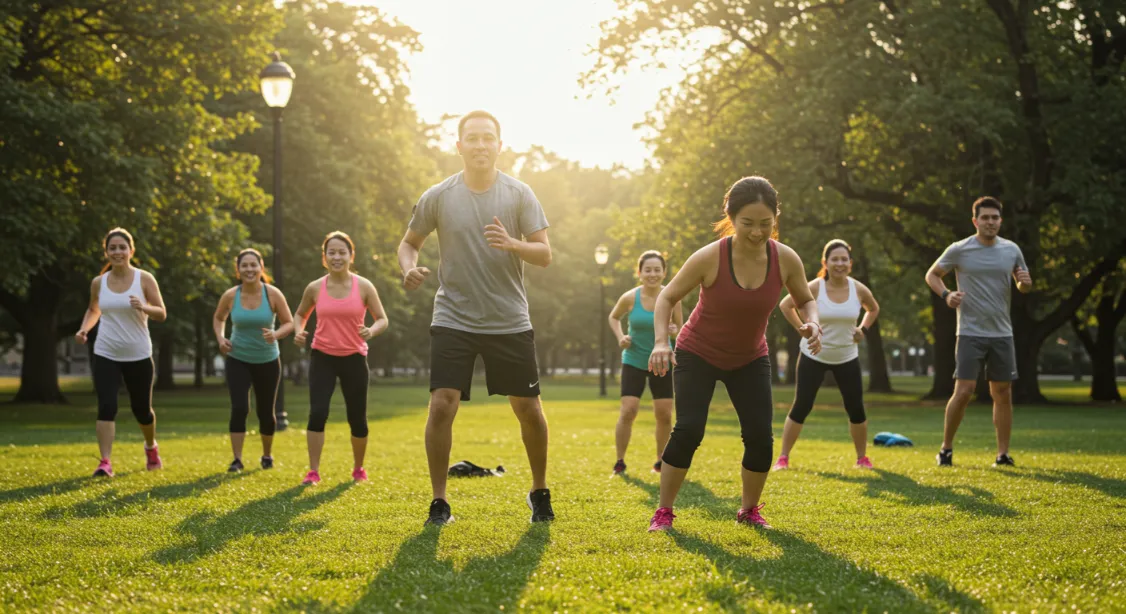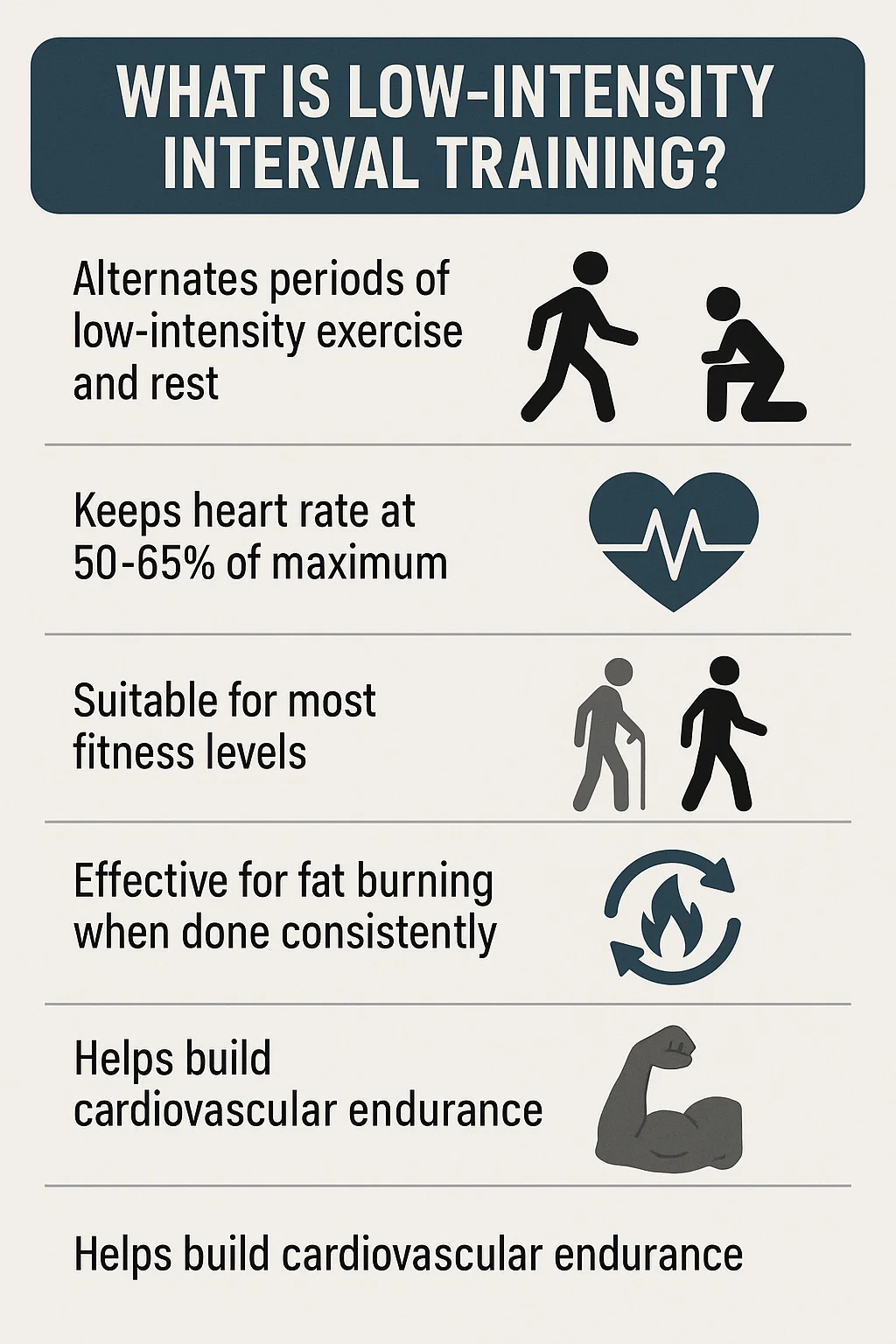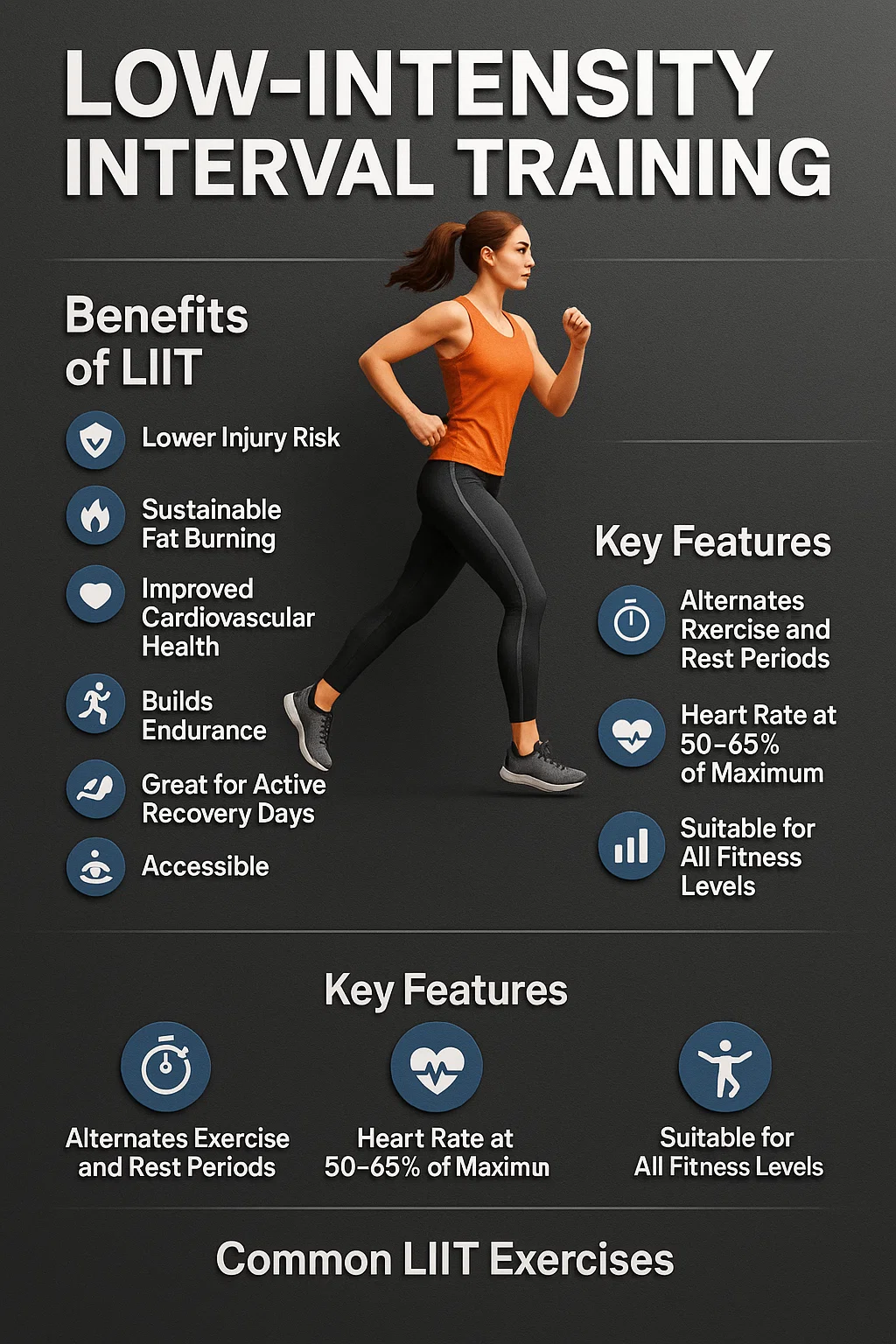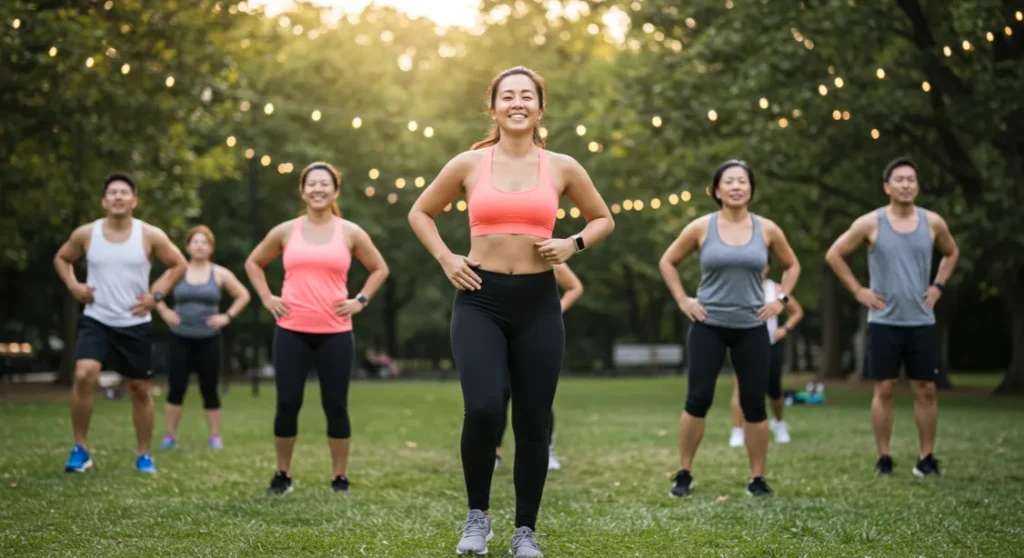Did you know that only about 23% of adults in the United States meet the recommended levels of physical activity? That’s a startling statistic from the Centers for Disease Control and Prevention (CDC).
Unlike the sweat-drenched, heart-pounding nature of HIIT workouts, LIIT offers a gentler approach that might just be what many exercisers need – especially those over 40 looking for effective but joint-friendly options.

Key Takeaways
- LIIT alternates between periods of low-intensity exercise and rest periods, making it accessible for most fitness levels
- Unlike HIIT, LIIT keeps your heart rate at about 50-65% of maximum, reducing injury risk while still providing benefits
- Perfect for recovery days, beginners, older adults, or those with joint issues
- Can effectively burn fat when done consistently due to its sustainability
- Complements higher intensity workouts in a balanced fitness routine
- Helps build cardiovascular endurance without excessive strain on the body
What is Low-Intensity Interval Training?

Low-Intensity Interval Training (LIIT) follows the same principle as its more famous relative (HIIT) – alternating between periods of activity and rest. The key difference lies in the intensity. While HIIT pushes you to 80-95% of your maximum heart rate, LIIT keeps you at a moderate 50-65%.
This gentler approach doesn’t mean less effective – it means different benefits and greater accessibility. During LIIT, you’ll work at a pace where conversation remains possible, unlike the breathless nature of high-intensity work.
A typical LIIT session might last 30-45 minutes (longer than many HIIT workouts) and include exercises like walking, light jogging, gentle cycling, or basic bodyweight movements with longer work periods (1-2 minutes) and shorter rest intervals.
LIIT vs. HIIT: Key Differences
The table below highlights the distinctions between Low-Intensity Interval Training (LIIT) and High-Intensity Interval Training (HIIT):
| Feature | LIIT | HIIT |
|---|---|---|
| Intensity | 50-65% max heart rate | 80-95% max heart rate |
| Duration | 30-45+ minutes | 10-30 minutes |
| Recovery Time | 24 hours or less | 48+ hours |
| Impact on Joints | Low impact | Higher impact |
| Ideal For | Beginners, recovery, older adults | Intermediate/advanced, time-crunched |
| Conversation Test | Can hold conversation | Difficult to speak |
This comparison showcases that LIIT is more suitable for those looking for a gentler, longer workout, while HIIT is geared toward individuals aiming for high-intensity, shorter sessions with significant recovery needs.
Who Benefits Most From LIIT?
Low intensity training shines for several populations:
- Beginners – Those new to exercise can build fundamental fitness without overwhelming their bodies
- Older adults – Particularly men over 40 seeking structured gym workouts find LIIT provides effective training with lower joint stress
- Recovery days – Athletes incorporate LIIT between high-intensity sessions to maintain activity while allowing recovery
- Injury-prone individuals – People with joint issues or previous injuries can stay active safely
- Those seeking sustainable fitness – The gentler nature of LIIT supports long-term adherence
Why LIT Beats Intense Workouts (Sometimes):
- Lower Injury Risk: Low-impact exercise is kinder to joints, crucial if you have existing conditions or are new to exercise. It reduces the risk of injury compared to high-intensity workouts or intense exercise.
- Sustainable Fat Burning: You can exercise for longer periods of time, boosting overall calorie burn and body fat reduction. Your body prioritizes fat as fuel at moderate intensities.
- Improved Strengthens your heart, improves blood circulation, and can lower blood pressure. Offers cardiovascular benefits similar to aerobic exercise but with less strain.
- Builds Endurance: Develops muscular endurance, particularly in slow-twitch muscle fibers (unlike HIIT, which targets fast-twitch muscle fibers).
- Great for Active Recovery Days: Helps you recover from high-intensity exercise or strength training exercises without overstressing your body. Use it on rest days.
- Boosts Mental Health: Reduces stress, improves sleep, and enhances cognitive health, similar to other forms of exercise.
- Accessible: Suitable for all fitness levels, including beginners. Low intensity exercise for beginners is a perfect starting point.
- It is one of the most common training styles.
- It improves aerobic fitness.
LIT vs. LIIT vs. LISS Cardio:
- LIT (Low-Intensity Training): The umbrella term for any exercise at a lower intensity.
- LIIT (Low-Intensity Interval Training): Alternating between periods of rest or very low effort and slightly higher (but still conversational) effort. Adds variety and can boost calorie expenditure.
- LISS (Low-Intensity Steady-State Cardio): Maintaining a consistent, steady pace throughout the workout (e.g., brisk walking at a casual pace).
Top Low-Intensity Activities (Actionable Choices):
- Walking: The easiest low intensity cardio. Aim for a brisk walking or even a casual walking pace where you can still talk. Track your steps – 10,000 steps is a good goal, but don’t get hung up on the myth of walking 10,000 steps a day.
- Cycling: Stationary bike or outdoor cycling at a moderate pace or slower pace. A fantastic low-impact cardio option.
- Swimming: Full-body, low impact, and excellent for cardiovascular fitness. Even water aerobics counts!
- Yoga: Hatha, restorative, or gentle flow yoga improve flexibility and reduce stress.
- Tai Chi: Promotes balance, flexibility in terms of movement, and relaxation.
- Elliptical Machine: Simulates running without the impact. Great for the gym.
- Rowing: Full-body workout at a gentler pace. Builds strength and endurance.
- Circuit training weight machines at a lower intensity.
LIIT Workout Example (Gym, 30 Minutes):
- Warm-up (5 mins): Light cardio (e.g., walking on the treadmill, exercise bike).
- Intervals (20 mins):
- Treadmill: 3 mins brisk walking, 1 min slightly faster (but still conversational). Repeat 5 times. Adjust the belt at intervals.
- Or use the elliptical, alternating between moderate intensities and a slightly higher intensity.
- Cool-down (5 mins): Gentle stretching.
Home LIIT Example (No Equipment, 20 Minutes):
Great for home workouts with minimal equipment:
- 5-minute light movement warmup
- Perform each exercise for 60 seconds at moderate intensity, then rest 30 seconds:
- Bodyweight squats
- Modified pushups
- Gentle lunges
- Shoulder taps
- Standing side bends
- Glute bridges
- Bird dogs
- Calf raises
- Complete 2-3 rounds
- 5-minute stretching cooldown
Total time: 25-35 minutes
Gym-Based LIIT Workout
For those with access to equipment:
- 5-minute light cardio warmup
- Perform 60 seconds of each exercise at moderate intensity with 30-second transitions:
- Recumbent bike (moderate resistance)
- Dumbbell squats (light weight)
- Resistance band rows
- Step-ups (low step)
- Light dumbbell shoulder press
- Stability ball hamstring curls
- TRX-assisted chest press
- Seated cable rotations
- Complete 2-3 rounds
- 5-minute stretching cooldown
Total time: 30-40 minutes
Getting Down to Brass Tacks: Your LIIT Workout Blueprint (LIIT Workout)
Alright, enough yapping about why. Let’s talk how. Crafting a LIIT workout is straightforward.
Structuring Your LIIT Session (Low Intensity Training Plan)
A typical low intensity training plan for a LIIT session looks like this:
- Warm-up (5-10 minutes): Gentle dynamic movements. Think arm circles, leg swings, light cardio like walking.
- Work Interval (e.g., 90 seconds to 3 minutes): Exercise at a moderate intensity. You should feel your heart rate elevate, breathing becomes more noticeable, but you’re not gasping for air. Aim for 60-80% of your Max Heart Rate (MHR), or a Rate of Perceived Exertion (RPE) of 3-5 on a 1-10 scale.
- Recovery Interval (e.g., 2-5 minutes): Slow down considerably. Very light activity, like slow walking or very easy cycling. The goal is to let your heart rate drop significantly before the next work interval.
- Number of Cycles: Repeat the work/recovery intervals for your desired workout duration, typically 30-60 minutes in total.
- Cool-down (5-10 minutes): Similar to the warm-up, bring your heart rate down gradually. Some light static stretching can be good here.
LIIT Exercise Ideas for the Gym (Men Over 40 Focus) (Low Intensity Workout Routine)
The beauty of a low intensity workout routine is its adaptability. Here’s how you can apply it using standard gym equipment:
- Treadmill:
- Work: Brisk walking (e.g., 3.5-4.5 mph at a slight incline) or a light jog.
- Recovery: Slow walking (e.g., 2.0-3.0 mph, no incline).
- Elliptical Trainer:
- Work: Steady, moderate pace with moderate resistance.
- Recovery: Slow pace with low resistance.
- Stationary Bike (Upright or Recumbent):
- Work: Moderate pedaling speed with moderate resistance.
- Recovery: Slow, easy pedaling with low resistance.
- Rowing Machine:
- Work: Controlled, rhythmic strokes at a moderate pace (e.g., 20-24 strokes per minute).
- Recovery: Very slow, easy strokes.
- Swimming (if your gym has a pool):
- Work: Laps at a moderate, sustainable pace (e.g., freestyle or breaststroke).
- Recovery: Very slow laps or treading water.
- Light Bodyweight or Resistance Machine Circuit: As a form of low intensity fitness, you can do a circuit of exercises like machine chest press, leg press, rows, bodyweight squats, or wall push-ups for a set time (e.g., 60-90 seconds per exercise) at a controlled pace, followed by a longer rest or very light movement period.
Example Low Intensity Workout Program (Easy Workout Plan)
Here’s a sample easy workout plan for a LIIT session on a treadmill:
Component | Activity | Duration | Intensity (RPE 1-10) | Notes |
Warm-up | Gentle walk, dynamic stretches | 5-10 mins | 1-2 | Prepare the body |
Work Interval 1 | Brisk Walk (e.g., 3.8 mph, 2% incline) | 3 mins | 4-5 | Breathing noticeable, can talk |
Recovery Interval 1 | Slow Walk (e.g., 2.5 mph, 0% incline) | 3 mins | 1-2 | Heart rate comes down |
Work Interval 2 | Brisk Walk (e.g., 4.0 mph, 2% incline) | 3 mins | 4-5 | Slightly increased pace if comfortable |
Recovery Interval 2 | Slow Walk (e.g., 2.5 mph, 0% incline) | 3 mins | 1-2 | Focus on recovery |
Work Interval 3 | Brisk Walk (e.g., 4.0 mph, 2.5% incline) | 3 mins | 4-5 | Maintain or slightly increase challenge |
Recovery Interval 3 | Slow Walk (e.g., 2.5 mph, 0% incline) | 3 mins | 1-2 | |
Repeat 2-4 more times as desired/able | ||||
Cool-down | Slow walk, static stretches | 5-10 mins | 1-2 | Gradually lower heart rate, stretch major muscles |
This is just a template. The key is to find your moderate and your easy. A heart rate monitor can be a useful tool here to keep you in the desired zones (Zone 2-3 for work, Zone 1 for recovery).
Incorporating LIIT Into Your Fitness Routine

LIIT isn’t meant to replace all other forms of exercise but rather to complement a well-rounded fitness approach. Here’s how to effectively include it in your routine:
As a Standalone Program
For beginners, older adults, or those with joint concerns, LIIT can serve as a complete program. Aim for 3-4 sessions per week, gradually increasing duration and adding gentle resistance training elements as fitness improves.
As Active Recovery
For those who engage in more intense training, LIIT makes an excellent active recovery option. Consider scheduling LIIT sessions between more demanding workouts to promote blood flow and recovery without adding significant stress.
Many endurance athletes incorporate LIIT during “easy” training days to maintain activity levels while allowing muscles to recover from harder sessions.
As Part of a Hybrid Approach
Perhaps the most effective approach combines different training intensities throughout the week. A balanced program might include:
- 1-2 HIIT sessions for maximal cardiovascular benefits
- 2-3 LIIT sessions for active recovery and additional fat-burning
- 1-2 strength training sessions for muscle maintenance
This variety not only provides comprehensive physical benefits but also adds mental variety that improves long-term adherence.
Common LIIT Mistakes to Avoid
Going Too Hard
The most common mistake with LIIT is treating it like HIIT-lite and pushing intensity too high. Remember that conversation should remain comfortable throughout a LIIT session. If you’re getting breathless, dial back the intensity.
Skipping Warmup/Cooldown
Even though LIIT is lower intensity, proper warmup and cooldown periods remain important for optimizing blood flow and preventing injury. Never skip these critical components.
Inconsistent Pacing
LIIT benefits from steady, consistent effort rather than sporadic bursts. Focus on maintaining even work intervals rather than starting too aggressively and fading.
Neglecting Progression
While LIIT is gentler than HIIT, it still requires progressive overload for continued improvement. Gradually increase duration, reduce rest periods, or add light resistance to continue making gains.
How to Monitor Your LIIT Intensity
Unlike HIIT where pushing to maximum effort is the goal, LIIT requires more nuanced intensity management. Here are effective ways to ensure you’re working in the appropriate range:
The Talk Test
During LIIT, you should be able to carry on a conversation with only slight breathlessness. If you can sing easily, increase intensity slightly; if you can’t speak in complete sentences, reduce intensity.
Heart Rate Monitoring
If using a heart rate monitor, aim to stay between 50-65% of your maximum heart rate. Calculate your rough maximum heart rate by subtracting your age from 220, then multiply by 0.5-0.65 to find your target range.
For a 45-year-old, this would mean working between 88-114 beats per minute (220-45 = 175 × 0.5-0.65).
Rate of Perceived Exertion (RPE)
On a scale of 1-10, with 10 being maximum effort, LIIT should feel like a 4-6. You’re working, but not straining.
LIIT for Special Populations

LIIT for Seniors
Older adults benefit tremendously from LIIT’s low-impact nature. Focus on seated exercises, water-based movements, or walking intervals. Include balance elements when appropriate, and ensure proper support during all movements.
For seniors new to exercise, working with a qualified trainer to develop a safe LIIT program is recommended. Many find interval training benefits for seniors include improved mobility and independence.
LIIT During Pregnancy
For expectant mothers (with physician approval), LIIT provides an excellent way to maintain fitness with minimal risk. Focus on walking, swimming, or stationary cycling with appropriate modifications as pregnancy progresses.
Always consult with healthcare providers before beginning any exercise program during pregnancy, and be prepared to adjust as your body changes.
LIIT for Rehabilitation
Those recovering from injuries often benefit from LIIT as they rebuild fitness. Working closely with physical therapists, LIIT can bridge the gap between rehabilitation exercises and return to regular activity.
The controlled nature of LIIT allows for careful monitoring of problem areas while maintaining overall fitness.
Nutrition to Support LIIT
While LIIT doesn’t demand the same nutritional considerations as high-intensity exercise, proper fueling still matters:
- Pre-workout: Light, easily digestible carbohydrates 30-60 minutes before LIIT can provide energy without digestive discomfort. A piece of fruit or small yogurt works well.
- Hydration: Even though you may not sweat as profusely as during HIIT, staying hydrated remains critical. Aim to drink water before, during, and after your session.
- Recovery: A balanced meal with moderate protein within a few hours of LIIT helps support muscle maintenance. Heavy recovery nutrition typically isn’t necessary after LIIT sessions.
For more comprehensive nutrition guidance, consider exploring nutrition plans tailored to your specific needs.
The Future of LIIT
As fitness science evolves, LIIT is gaining recognition as a valuable training methodology rather than simply “easier HIIT.” Research increasingly supports its unique benefits, particularly for long-term health and fitness adherence.
Modern fitness trackers now offer LIIT-specific tracking features, helping users maintain appropriate intensity levels throughout their workouts. Technology in fitness continues advancing to support all training methodologies, including lower-intensity options.
Industry experts predict continued growth in LIIT programming as the fitness community increasingly recognizes the value of sustainable, joint-friendly training approaches that promote lifelong activity.
Conclusion
Low intensity interval training offers a powerful alternative to the “no pain, no gain” mentality that dominates much of fitness culture. By providing cardiovascular, fat-burning, and mental health benefits with minimal joint stress and reduced injury risk, LIIT deserves consideration in virtually any fitness routine.
Whether you’re just beginning your fitness journey, recovering from higher-intensity work, managing joint issues, or simply seeking a more sustainable approach to lifelong fitness, LIIT provides an evidence-based option worth exploring.
Remember that consistency ultimately trumps intensity for long-term health and fitness success. The most effective exercise program is one you can maintain for years, not weeks—and for many people, incorporating LIIT makes that sustainability possible.
References:
[1] https://www.onepeloton.com/blog/low-intensity-interval-workouts-liit/
[2] https://www.puregym.com/blog/10-low-impact-hiit-exercises-and-workouts-that-won-t-hurt-your-knees-or-back/
[3] https://www.bellicon.com/en-eu/magazine/sport/low-intensity-interval-training/
[4] https://jackhanrahanfitness.com/liit-workouts-get-fitter-and-recover-faster/
[5] https://www.shu.ac.uk/gym/keeping-active-at-home/low-intensity-workouts
[6] https://www.nordictrack.co.uk/learn/all-you-need-to-know-about-liit-or-low-intensity-interval-training/
[7] https://www.livestrong.com/article/557788-the-effects-of-low-intensity-cardio/
[8] https://www.goodrx.com/well-being/movement-exercise/low-intensity-interval-training
[9] https://www.webmd.com/fitness-exercise/what-to-know-low-intensity-workouts
[10] https://darebee.com/collections/liit-workouts.html
[11] https://www.polar.com/blog/liit-low-intensity-interval-training/
[12] https://www.stlukeshealth.org/resources/7-low-intensity-workouts-actually-make-difference
[13] https://darebee.com/fitness/liit-exercise-program-for-weightloss-fitness.html
[14] https://health.clevelandclinic.org/low-intensity-interval-training
[15] https://www.healthline.com/health/exercise-fitness/liss-cardio
[16] https://theconversation.com/low-intensity-interval-training-can-be-as-effective-as-hiit-but-only-if-you-spend-more-time-working-out-135251
[17] https://www.healthline.com/health/fitness-exercise/low-impact-cardio
As a veteran fitness technology innovator and the founder of GearUpToFit.com, Alex Papaioannou stands at the intersection of health science and artificial intelligence. With over a decade of specialized experience in digital wellness solutions, he’s transforming how people approach their fitness journey through data-driven methodologies.
